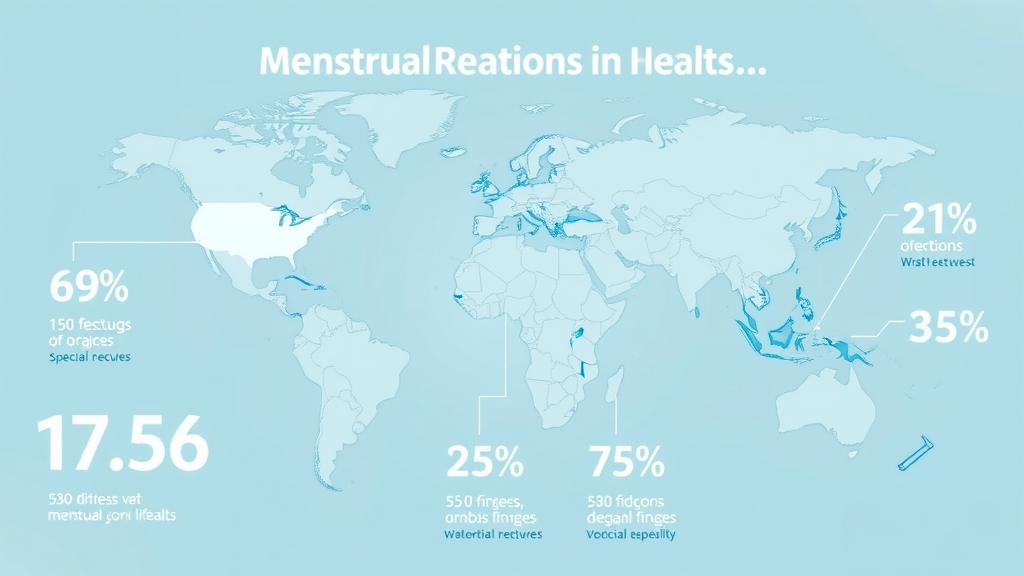Did you know that more than 500 million women and girls globally don’t have adequate support for their menstrual health? This gap doesn’t just influence hygiene—it impacts reproductive health, emotional well-being, and everyday life. If you’re tired of dealing with period problems or want to champion better menstrual health for yourself and your community, read on for actionable tips and eye-opening insights. Taking control of your menstrual cycle isn’t just about personal comfort; it’s a powerful move for gender equality and human rights worldwide.
Menstrual Health: Surprising Facts That Demand Immediate Attention

- Recent studies reveal that over 500 million women worldwide lack adequate menstrual health support—an alarming gap affecting menstrual hygiene, overall well-being, and day-to-day life.
The sheer scale of menstrual health gaps is astonishing. Despite advances in public health and hygiene, a staggering percentage of people who menstruate still lack access to basic sanitation facilities and appropriate menstrual products . These issues extend across all continents, affecting individuals in both developed and developing nations. According to official data provided on the website of the United States government and reports from government organizations worldwide, inadequate menstrual care is directly linked to infections, school absenteeism for adolescent girls, and even lower workplace productivity for adult women.
Beyond the physical consequences, these statistics highlight a profound social and economic cost. When women and girls don’t have adequate menstrual health support, it doesn’t just affect them; it shapes the health, productivity, and equality of entire communities. As agencies strive toward sustainable development goals , addressing menstrual health has become a major indicator for progress in gender equality, reproductive health, and access to education around the globe.
Understanding Menstrual Health: The Essentials Every Woman Should Know
Defining Menstrual Health and Its Crucial Role

Menstrual health encompasses much more than the monthly occurrence of a period. At its core, it involves the physical, emotional, and social well-being associated with the menstrual cycle . This includes having access to timely, accurate information, safe menstrual products , private and sanitary sanitation facilities , as well as ongoing support for menstrual-related challenges.
Every woman, adolescent girl, and individual who menstruates deserves to manage their menstrual hygiene safely, with dignity and privacy. Failure to prioritize menstrual health puts women and girls at heightened risk for tract infection , reduced reproductive health, and a compromised sense of self-worth. This is why menstrual health and hygiene must be acknowledged as fundamental human rights and a cornerstone for gender equality .
The broader picture is clear: achieving good menstrual health is a vital step toward advancing the sustainable development goals . Societies that support menstrual well-being enable healthier, happier, and more empowered lives for women and girls everywhere.
Dissecting the Menstrual Cycle: Phases, Hormones, and Patterns
The menstrual cycle isn’t just about a monthly bleed; it’s a precise, hormone-driven journey with several crucial phases: menstruation, follicular, ovulation, and luteal. Each phase is guided by changes in estrogen, progesterone, and other hormones that affect not only the reproductive system but also mood, energy levels, and physical symptoms. Understanding these natural patterns helps you predict and manage shifts in your body and emotional state.
Regular tracking can identify what’s normal for you and spot early warning signs of potential issues. Cycle irregularities, heavy bleeding, or severe cramping may indicate underlying health concerns—sometimes as severe as polycystic ovary syndrome (PCOS) or endometriosis. Being well-informed empowers women and girls to seek timely medical advice and break the silence around menstrual health challenges.
Embracing knowledge about your menstrual cycle promotes better health and hygiene choices. It encourages adopting practices—such as healthy nutrition and regular exercise—that enhance hormonal balance, menstrual hygiene, and emotional resilience. When you know your cycle, you become an active advocate for your own well-being.
What You Need to Know About Menstrual Health and Hygiene
- How maintaining menstrual hygiene goes beyond basic cleanliness —impacts menstrual health, reproductive health, and even emotional balance.
Good menstrual hygiene isn’t just a matter of comfort—it’s about protecting yourself against infections, supporting reproductive health, and ensuring daily well-being. The lack of sanitary products or poor hygiene practices can lead to irritation, skin problems, and more serious risks such as tract infection or even fertility complications. Women and girls who lack access to safe products, clean water, and private bathrooms are particularly vulnerable.
The ripple effect is clear: poor hygiene impacts education for adolescent girls , workforce participation, and even broader development goals. Fortunately, there are clear steps anyone can take to improve their menstrual health, regardless of budget or location. By choosing the right menstrual products and adopting proper sanitation and hygiene practices , you lay the foundation for a healthier, more confident life.
It is essential for every woman, girl, and community to be equipped with the latest knowledge on menstrual health and hygiene. With supportive environments and access to accurate information—often provided by gov websites or advocacy nonprofits—menstrual health can be managed proactively, safely, and with dignity.
Key Hygiene Practices to Enhance Menstrual Health

Practicing consistent and proper hygiene is the cornerstone of healthy periods. Here are key hygiene practices every woman and girl should follow for better menstrual health and hygiene :
- Change sanitary products regularly —Whether using sanitary pads, tampons, or menstrual cups, replacing them at recommended intervals (4-8 hours for pads/tampons) is critical to avoid infection.
- Wash hands thoroughly —Before and after handling any menstrual products , thorough handwashing is non-negotiable. This simple act greatly reduces the risk of contamination.
- Maintain intimate hygiene —Gently cleanse the genital area daily with warm water. Avoid harsh soaps or douching; these can disturb healthy bacteria and natural pH.
- Proper disposal —Dispose of used sanitary pads and tampons hygienically. Do not flush them down the toilet, as this can block plumbing and harm the environment.
- Choose quality products —Use trusted brands or locally recommended items, ensuring you’re protected against allergic reactions and irritation.
Sticking to these hygiene practices not only keeps periods comfortable but also dramatically lowers the risk of reproductive tract infection, embarrassing odors, and skin issues. For adolescent girls especially, learning strong menstrual hygiene routines early builds a lifetime of health and self-assurance.
Menstrual Products: Choosing What’s Best for You
There’s no one-size-fits-all answer when it comes to menstrual products . Options include disposable sanitary pads, tampons, reusable cloth pads, menstrual cups, and special period underwear. Choosing the right solution depends on your flow, health needs, budget, comfort, and local availability. For some, menstrual cups offer eco-friendly benefits and cost savings, while others may prefer the familiarity of sanitary pads or the discreetness of tampons.
It's important to review the pros and cons of each type. Pads are easy to use and widely available but can feel bulky for some; tampons offer more freedom of movement but should not be worn for extended periods; menstrual cups can last for years but require regular boiling and careful cleaning. Inadequate or poor-quality products can irritate the skin or increase infection risk—so always prioritize certified or reputable brands. Check official websites, or visit a local NGO-supported clinic, for up-to-date reviews.
Remember, your comfort and health come first. Give yourself permission to experiment and listen to your body. The best product is one that meets your practical needs, fits your lifestyle, and supports sustainability wherever possible.
Personal Opinion: Why Society Should Prioritize Menstrual Health for Women and Girls
"Neglecting menstrual health means neglecting basic human rights and gender equality. Every woman and girl deserves safety, dignity, and empowerment."
Menstrual health isn’t just a private issue—it’s a social justice matter. By ignoring the needs of people who menstruate, we undermine human rights and block progress toward gender equality. When women and girls have the resources and education to manage their periods safely, they can participate fully in school, work, and society. I believe that meaningful investment in menstrual health sends a clear message: everyone is entitled to dignity and agency over their bodies.
Societies that prioritize menstrual health actively break down taboos and foster environments of respect and inclusion. These efforts must extend to policy change, improved sanitation in public spaces and schools, as well as targeted programming for disadvantaged or rural populations. When public officials, communities, and private companies work together, access to menstrual products and hygiene education becomes a collective victory—one that benefits everyone, not just women and girls.
Achieving sustainable development and true gender equality demands that we view menstrual health and hygiene not as optional extras but as fundamental human rights. It’s time every nation, including the United States , acknowledges what the evidence already shows: menstrual health is the foundation for lifelong well-being and societal progress.
Human Rights and Gender Equality Are Inseparable from Menstrual Health

Menstrual health sits at the intersection of human rights and gender equality . International guidelines—including those promoted by the united states government , United Nations, and other government organizations —stress that access to menstrual products , accurate information, and safe sanitation facilities are rights, not privileges. Unfortunately, millions, especially adolescent girls in underserved areas, still struggle for basic dignity during their menstrual period.
Denial of menstrual health resources perpetuates gender-based discrimination and hinders national achievement of sustainable development goals . True progress means every school, workplace, and public institution recognizes menstrual products as essential—not as luxury items. It also means smashing stigma: open conversations about periods should be the norm, not the exception. When we protect menstrual health, we actively advance gender equality in all corners of society.
On an individual level, supporting someone’s menstrual journey is a powerful act of empathy and social responsibility. On a systemic level, including menstrual health in health and hygiene programs, social welfare policies, and educational curricula has the power to transform lives and champion the rights of women and girls everywhere.
How to Fix Your Menstrual Health Issues Fast: My Tried & Tested Methods
- Track your menstrual cycle consistently
- Optimize your diet for better menstrual health
- Invest in safe, comfortable menstrual products
- Prioritize sleep and stress reduction
- Consult a healthcare provider if issues persist
Overcoming menstrual health issues doesn’t have to be a drawn-out struggle. Consistently tracking your menstrual cycle is the first step—use a period tracking app, a simple calendar, or a journal to note flow, symptoms, and any changes month-to-month. This empowers you to anticipate your cycle, plan activities, and notice any concerning symptoms for discussion with a health professional.
Next, focus on diet and lifestyle. A well-balanced diet rich in fresh produce, whole grains, and iron helps support hormonal balance and overall energy. Regular physical activity—walking, yoga, or whatever you enjoy—can reduce cramps and boost mood. Prioritize adequate sleep and learn stress reduction techniques, as chronic stress makes menstrual symptoms worse. And remember to invest in menstrual products that genuinely suit your needs; discomfort or leaks should never be the norm.
If you continue to experience irregular cycles, severe pain, or alarming changes, don’t hesitate to consult a medical provider. Early intervention is key to preventing bigger reproductive health issues down the road. With these actionable steps, you can take faster, more confident control of your menstrual health.
Dietary Tips and Lifestyle Changes That Improve Menstrual Health

Nutrition and lifestyle have a profound impact on the menstrual cycle and overall menstrual health . Include foods high in iron (like spinach, beans, or red meat), vitamin B12, and magnesium in your meals to reduce fatigue, ease cramping, and replenish what’s lost during your period. Omega-3 fatty acids from fish, flaxseed, or walnuts are also beneficial for reducing inflammation and mood swings.
Stay well-hydrated, aiming for at least eight glasses of water per day to avoid bloating and help flush toxins. Limit processed sugars and salty snacks, which may worsen bloating or discomfort. If you’re prone to anemia, which is common during heavy periods, discuss iron supplementation with your doctor.
Beyond what you eat, lifestyle choices such as daily movement, gentle stretching, mindfulness, and relaxation exercises can make periods lighter and less painful. A few adjustments can turn your menstrual health around, making each cycle more manageable and less disruptive to daily life.
Avoiding Common Menstrual Health Mistakes
- • Neglecting hygiene practices
- • Ignoring abnormal menstrual cycle symptoms
- • Self-medicating without expert guidance
- • Using unsuitable menstrual products
It’s surprisingly easy to make mistakes that jeopardize menstrual health and hygiene . Neglecting regular hygiene practices is the leading cause of irritation and reproductive tract infection. Always change sanitary products at proper intervals and stay mindful about intimate cleanliness—even on busy or low-symptom days.
Ignoring irregularities in your menstrual cycle —such as sudden changes in length, heaviness, or missed periods—can delay treatment for serious health issues. Self-medicating for pain without proper diagnosis, or relying on unregulated products, may mask deeper problems or cause avoidable side effects.
Lastly, using the wrong kind of menstrual product for your unique needs can lead to discomfort, leaks, or allergic reactions. Choose wisely, consult official websites or trusted medical professionals, and always stay vigilant for signs your body needs something different.
Signs of Poor vs. Good Menstrual Health: Spot the Red Flags
| Aspect | Good Menstrual Health | Poor Menstrual Health |
|---|---|---|
| Symptoms | Minimal discomfort, no severe pain, predictable periods | Severe cramps, heavy bleeding, clotting, fatigue, frequent infections |
| Cycle Regularity | Cycle ranges 21-35 days, consistent flow | Irregular periods, missed cycles, unexpected spotting |
| Hygiene Practices | Regular changing of menstrual products, proper cleansing | Sporadic hygiene, use of inappropriate or expired products |
| Emotional Impact | Stable mood, minimal anxiety or depression | Significant mood swings, stress, withdrawn behavior |

Spotting warning signs early can safeguard against future complications. Severe pain, cyclical unpredictability, fatigue, persistent odor, or mood instability are all red flags indicating poor menstrual health. On the other hand, regular cycles, minimal discomfort, proper hygiene, and a balanced emotional state are markers of good menstrual health.
If you consistently experience any symptoms listed in the ‘poor’ column, don't dismiss them as "normal." Each woman's experience is unique, but ongoing issues deserve professional attention. By listening to your body and responding promptly, you put yourself on a proactive path to better health.
Take advantage of digital tools—health apps and trackers supported by official websites—to maintain detailed records and communicate more effectively with your healthcare provider when needed. Vigilance is key for long-term reproductive and emotional well-being.
The Broader Impact: Menstrual Health, Mental Well-being, and Social Inclusion
Menstrual health affects not only the body, but also self-confidence, educational attainment, and social integration. When women and girls feel empowered to talk openly about their periods, they break longstanding societal stigmas. Conversely, shame and silence increase the risk of absenteeism from school or work, disrupt personal relationships, and fuel mental health struggles such as anxiety or depression.
Open dialogue and positive role models help create safe spaces for women and girls to seek advice and support. Fathers, teachers, and community leaders should become comfortable engaging in these conversations, reinforcing that menstrual health is a shared community concern, not a solitary burden.
By integrating menstrual health topics into health curricula, wellness initiatives, and local advocacy, we fuel a culture of respect and social inclusion—unlocking higher participation, retention, and joy in every area of society.
Menstrual Health and Well-being: Breaking the Stigma for Women and Girls

The most effective way to tackle menstrual stigma is through public education and community support. When women and girls share their experiences candidly, society pushes back against outdated taboos. Well-designed awareness campaigns—many backed by government organizations or NGOs—bring topics like menstrual hygiene, product choice, and reproductive health out of the shadows.
Celebrating menstrual health as a normal, manageable part of life makes it less likely girls will skip school or women will withdraw from their communities during their period. As governments and advocates champion policies aligning with development goals and gender parity, long-standing barriers begin to crumble.
Each voice matters. By supporting someone through their menstrual health journey or challenging negative stereotypes, you contribute to a wave of positive change, helping all women and girls thrive.
Menstrual Health FAQs Answered by Experts
How do I improve my period health?
Start by tracking your menstrual cycle and adopting consistent hygiene practices. Eat a balanced diet, stay hydrated, manage stress, and get enough sleep. Select menstrual products that are comfortable and safe, and always consult a healthcare provider if you notice irregularities or severe symptoms.
What is meant by menstrual health?
Menstrual health means the overall well-being—including physical, emotional, and social aspects—related to the menstrual cycle. It covers access to sanitary products and information, safe and private facilities, and the ability to manage your period with dignity and confidence.
What is considered good menstrual health?
Good menstrual health is marked by regular cycles, manageable discomfort, adherence to hygiene routines, access to quality products, minimal emotional disruption, and freedom from infections or complications. Emotionally, it means feeling empowered and not restricted by menstruation.
What is poor menstrual health?
Poor menstrual health surfaces as irregular cycles, heavy or unpredictable bleeding, persistent pain, lack of access to clean products or facilities, infections, and significant mental distress. Ignoring these symptoms can lead to more serious reproductive or overall health problems.
Key Resources and Advocacy for Menstrual Health and Hygiene
- • NGOs and resources supporting menstrual health
- • Educational materials for menstrual health and hygiene
- • Where to find affordable menstrual products locally and online

There are numerous organizations—both global and grassroots—that provide menstrual health education, distribute free or low-cost menstrual products, and fight policy battles for better access. Look for materials from NGOs, the official website of the United States government, and local health departments for trustworthy advice and product reviews.
Educational campaigns now reach more women and girls than ever, with guides on choosing products, avoiding infections, and managing period pain. Online platforms and support groups are also powerful places to share tips and find emotional encouragement.
Thanks to the work of activists and advocates, affordable menstrual materials and sanitation products are increasingly available, both locally in health clinics and online. Spreading the word about these resources helps ensure that no woman or girl is left behind.
Take Action Now: Prioritize Your Menstrual Health for Lasting Well-being
- Empower yourself—seek professional advice, share awareness within your community, and invest in menstrual health as a fundamental human right.
Your menstrual health is worth every effort. Stand up for your well-being, educate those around you, and contribute to a world where periods are safe, healthy, and respected.
Watch: Understanding Menstrual Health and Hygiene Practices
Informative explainer on the basics of menstrual health and simple hygiene practices for all ages.
Conclusion
Take ownership of your menstrual health: adopt best practices, choose the right products, consult professionals, and advocate for yourself and your community starting today.
To further enhance your understanding of menstrual health, consider exploring the following resources:
-
The Centers for Disease Control and Prevention (CDC) provides comprehensive guidelines on menstrual hygiene practices, including the proper use of menstrual products and hygiene tips to prevent infections. ( cdc.gov )
-
UNICEF offers insights into the global challenges of menstrual health, emphasizing the impact of gender inequality and poverty on menstrual hygiene management. ( unicef.org )
These resources offer valuable information to help you manage your menstrual health effectively and advocate for broader awareness and support.
 Add Row
Add Row  Add
Add 




Write A Comment